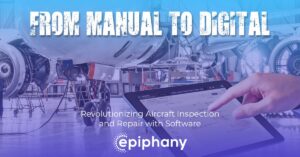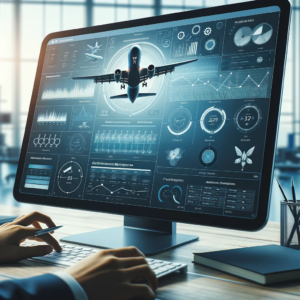The aviation industry has always been a pioneer in embracing cutting-edge technology to ensure safety, efficiency, and innovation. Maintenance, Repair, and Overhaul (MRO) operations, the backbone of aviation safety and operational readiness, are undergoing a significant transformation. This transformation is largely driven by the integration of next-generation software solutions designed to address the increasingly complex needs of modern aircraft and MRO processes. In this article, we explore the current landscape of aviation MRO, the potential of predictive maintenance, the role of emerging technologies such as Augmented Reality (AR) and Virtual Reality (VR), the benefits of IoT, and the importance of mobile and cloud computing in revolutionizing the industry.
The Evolving Landscape of Aviation MRO
Traditionally, aviation MRO processes were heavily reliant on manual procedures, including handwritten logs, physical inspections, and direct communication among personnel. These methods, while effective in their time, are no longer sufficient to meet the demands of today’s advanced aircraft. The introduction of digital transformation in MRO has brought about computerized maintenance management systems (CMMS), electronic logs, and mobile platforms. These advancements have streamlined MRO processes, but as aircraft continue to evolve, there is a pressing need for more sophisticated technology integration to maintain a competitive edge.
Leveraging Predictive Maintenance for Optimized Operations
Predictive maintenance has emerged as one of the most promising advancements in aviation MRO. By utilizing data analytics and machine learning, predictive maintenance software can forecast when components are likely to fail, allowing maintenance to be scheduled proactively. This approach not only minimizes unscheduled downtimes but also reduces the overall cost of maintenance by preventing more significant issues.
Key Benefits of Predictive Maintenance:
- Decreased Downtimes: Scheduled maintenance during non-peak times ensures minimal disruption to operations.
- Cost Savings: Early detection of potential issues allows for repairs before they escalate, avoiding costly emergency interventions.
- Enhanced Safety: Anticipating and addressing potential failures before they occur significantly improves operational safety.
The Role of Augmented Reality (AR) and Virtual Reality (VR) in MRO
The incorporation of AR and VR technologies in MRO processes is transforming how maintenance tasks are performed and how technicians are trained. These technologies provide a more immersive and interactive way to approach complex maintenance procedures.
Augmented Reality in MRO:
- Enhanced Repair Processes: AR allows technicians to overlay digital information, such as schematics or instructions, directly onto physical aircraft components, guiding them through the repair process with precision.
- Remote Assistance: Experts can remotely assist on-site technicians by viewing the same AR feed, ensuring that the highest level of expertise is available for every repair, regardless of location.
Virtual Reality in MRO:
- Training Simulations: VR enables technicians to practice maintenance tasks in a virtual environment, reducing the risk of errors when performing these tasks on actual aircraft.
- Facility Design: Planners can use VR to walk through virtual representations of maintenance facilities before they are built, ensuring that the layout is optimized for efficiency and safety.
Harnessing the Internet of Things (IoT) for Real-Time Data and Insights
The Internet of Things (IoT) is set to revolutionize MRO by providing real-time data from interconnected sensors placed throughout the aircraft. These sensors continuously monitor various parameters and transmit data to centralized software platforms for analysis.
Examples of IoT Applications in MRO:
- Vibration Analysis: Detecting abnormal vibrations in engines, which could indicate potential issues that require attention.
- Hydraulic Pressure Monitoring: Sensors can detect changes in hydraulic pressure, signaling possible leaks that need to be addressed before they escalate.
- Temperature Monitoring: Elevated temperatures in electronic components can be identified early, allowing for preventive maintenance before failure occurs.
The Impact of Mobile and Cloud Computing on MRO Efficiency
Mobile devices and cloud computing have become indispensable tools in modern MRO operations. The portability of mobile devices allows technicians to access essential information, such as schematics and maintenance records, on the go, reducing paperwork and improving accuracy.
Advantages of Cloud Computing in MRO:
- Real-Time Access: Data can be accessed in real-time from any location, facilitating faster decision-making and improved collaboration among teams.
- Enhanced Collaboration: Cloud-based platforms allow teams across different locations to collaborate seamlessly, ensuring that everyone has access to the same up-to-date information.
- Secure Data Backups: Important MRO data is securely backed up in the cloud, reducing the risk of data loss and ensuring continuity of operations.
Overcoming Challenges in Software Integration
While the benefits of integrating next-generation software solutions in MRO are clear, the process is not without its challenges. Concerns about cybersecurity, the learning curve associated with new technologies, and the initial setup costs are significant considerations. Additionally, there is no one-size-fits-all solution; MRO systems must be tailored to the specific needs and capacities of each airline or maintenance provider to be effective.
Leading the Charge in Aviation MRO Innovation
The future of aviation MRO is poised for dramatic advancements as new technologies continue to be integrated into existing processes. Companies that lead the charge in adopting and refining these innovations will set the standard for the industry. By embracing predictive maintenance, AR, VR, IoT, and cloud computing, MRO providers can enhance operational efficiency, reduce costs, and improve safety. As we look to the future, the integration of these technologies will not only redefine how maintenance is performed but also ensure that the aviation industry remains at the forefront of technological innovation.






